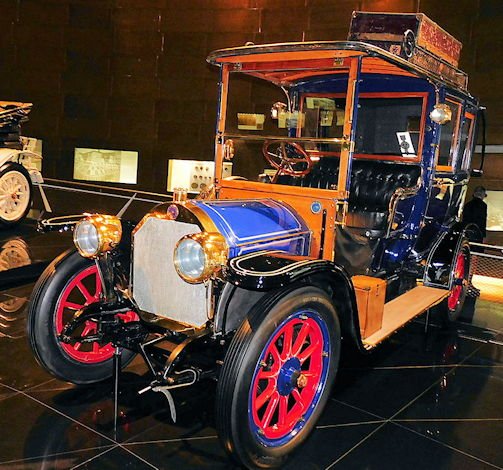Benz 20/35 hp
 | |
Production period: | 1909 to 1911 |
Class : | Motor Car |
Body versions : | Double Phaeton ,Sedan , Landaulet |
Engines: | Gasoline :4.85-5.2 litres |
Wheelbase: | 3090-3210 mm |
Curb weight : | 1050-1200 kg |
previous model | Benz 28/30 hp |
successor | Benz 16/35 hp |
The Benz 20/35 hp was an evolution of the Benz 28/30 hp in the 1910s .
History
Technical progress caught up with Benz, who thought he had devised the perfect motor-car, and left him far behind. By 1902, when the original type was finally discontinued, the feeble, frail-looking, elementary Benz with its lazy horizontal engine, belt final drive, vestigial power output, and gentle 15—20 m.p.h. pace, which had been so popular up to 1900, was now a museum piece. The car was initially equipped with a four-cylinder in-line engine with 5195 cc capacity, which developed 35 hp (26 kW) at 1400 rpm One German fiscal horsepower corresponded to 16 cubic inch engine displacement. The engine power was transmitted via a leather cone clutch to a four-speed gearbox and from there, depending on the customer's request via chains or a cardan shaft to the rear wheels.
The firm took a long time to make up the lost ground (which meant catching up with Mercedes and Renault from the time the new designer, Marius Barbarou, formerly of Clement-Gladiator, were an advance on their predecessors, but were still too conservative to be competitive. However, in 1904, Barbarou (who went back to France, and Delaunay-Belleville) was replaced as works manager by Hans Nibel, who produced a line of cars of conventional modern design, quite expensive, some medium- sized but owing their reputation to the big, fast cars in the range. All were fours until 1914, with pair-cast cylinders. The early Nibel cars had side valves in a T head, but he adopted the L-head layout in 1909. Shaft drive could be fitted to the 18/28 PS of 1905—8 as an option, but the largest machines could only be had with chain drive until 1908, and only in that year
was a model offered with shaft drive alone. The top speed was 45mph ( 75 km/h), the fuel consumption at 22 l / 100 km. 1910, the capacity was reduced while maintaining power to 4850 cc.



